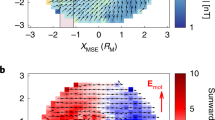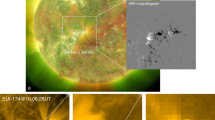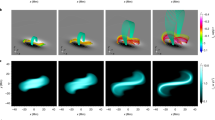Abstract
The interplanetary magnetic field near the ecliptic plane is characterized both by its variability in direction and by its constancy of magnitude. Exceptions to this constancy are depressions in magnitude associated with current sheets and the occasional compressions associated with shocks and stream–stream interactions. Pioneer Venus, orbiting Venus 0.72 AU from the Sun, has encountered an even rarer change in the magnitude of the magnetic field, a slow rise to a sharp maximum and then a decay, surrounding a strong current sheet. Similar structures have apparently not been reported to occur in the interplanetary medium. A survey of three years of both ISEE3 and Pioneer Venus interplanetary magnetic field data reveals what are perhaps small analogues of this feature. However, these features are an order of magnitude shorter in duration and about a factor of three smaller in amplitude. These too are rare, occurring about twice per year on average in both sets of data. An explanation that is consistent with these observations is that Venus passed through the wake of an active comet; other possible explanations seem less likely. However, no known comet was near Venus at the time of this observation. If the observed disturbance was in fact caused by a comet, the symmetry of the signature suggests that it was near perihelion. The signature in plasma and field, described here, indicates that its orbit would be prograde and inclined to the orbit of Venus. The putative comet seems to have approached Venus from above the ecliptic plane.
This is a preview of subscription content, access via your institution
Access options
Subscribe to this journal
Receive 51 print issues and online access
$199.00 per year
only $3.90 per issue
Buy this article
- Purchase on Springer Link
- Instant access to full article PDF
Prices may be subject to local taxes which are calculated during checkout
Similar content being viewed by others
References
Klein, L. W. & Burlaga, L. F. J. geophys. Res. 87, 613–624 (1982).
Ness, N. F. Space Sci. Rev. 21, 527–553 (1978).
Russell, C. T., Luhmann, J. G., Elphic, R. C. & Scarf, F. L. Geophys. Res. Lett. 8, 843–846 (1981).
Biermann, L. in Solar Wind III (ed. Russell, C. T.) 396–414 (IGPP, University of California, 1974).
Wallis, M. Planet. Space Sci. 21, 1647–1660 (1973).
Intriligator, D. S., Wolfe, J. H. & Mihalov, J. D. IEEE Trans. Geosci. Remote Sensing GE-18, 39–43 (1980).
Krehbiel, J. P. et al. IEEE Trans. Geosci. Remote Sensing GE-18, 49–54 (1980).
Ershkovich, A. I. Mon. Not. R. astr. Soc. 184, 755–758 (1978).
Spreiter, J. R. & Stahara, S. S. J. geophys. Res. 85, 7715–7738 (1980).
Russell, C. T., Luhmann, J. G., Elphic, R. C., Scarf, F. L. & Brace, L. H. Geophys. Res. Lett. 9, 45–48 (1982).
Author information
Authors and Affiliations
Rights and permissions
About this article
Cite this article
Russell, C., Luhmann, J., Barnes, A. et al. An unusual interplanetary event: encounter with a comet?. Nature 305, 612–615 (1983). https://doi.org/10.1038/305612a0
Received:
Accepted:
Issue Date:
DOI: https://doi.org/10.1038/305612a0
This article is cited by
-
Identification of comet Hyakutake's extremely long ion tail from magnetic field signatures
Nature (2000)
-
The multiple modes of interaction of the solar wind with a comet as it approaches the Sun
Earth, Moon, and Planets (1984)
Comments
By submitting a comment you agree to abide by our Terms and Community Guidelines. If you find something abusive or that does not comply with our terms or guidelines please flag it as inappropriate.



